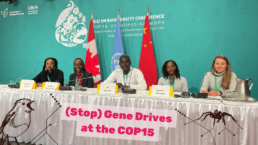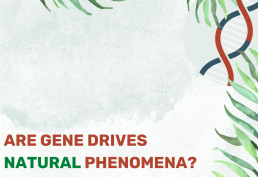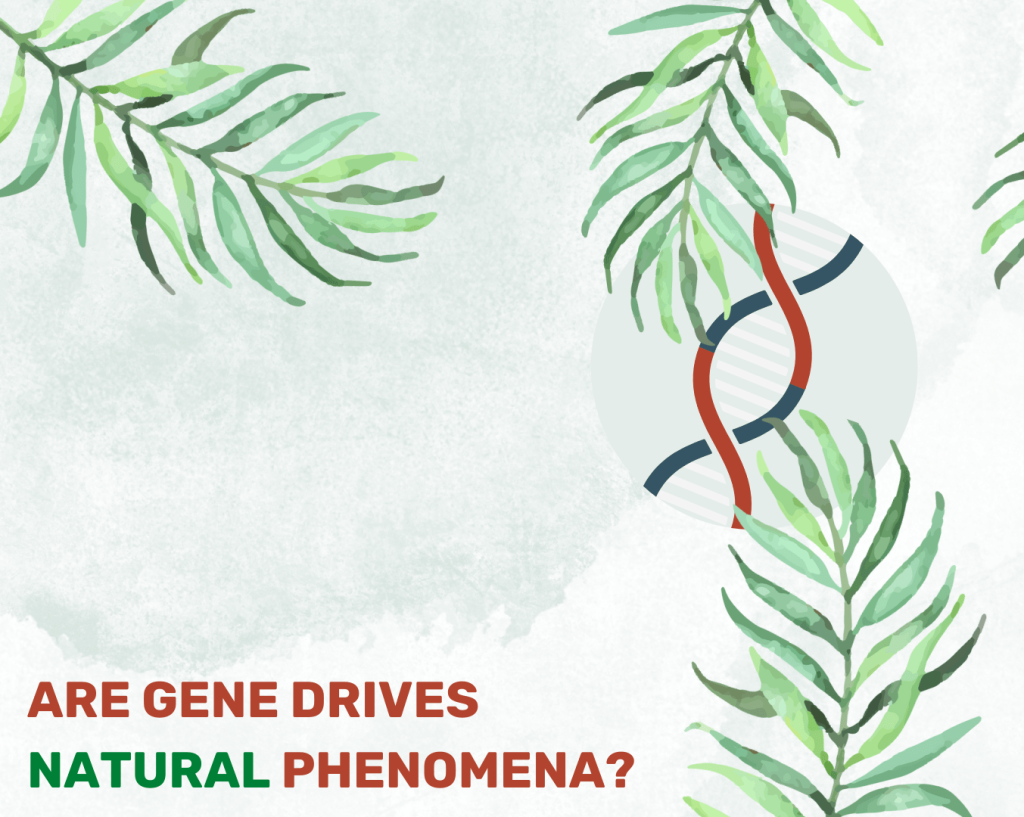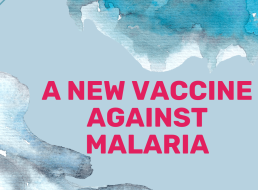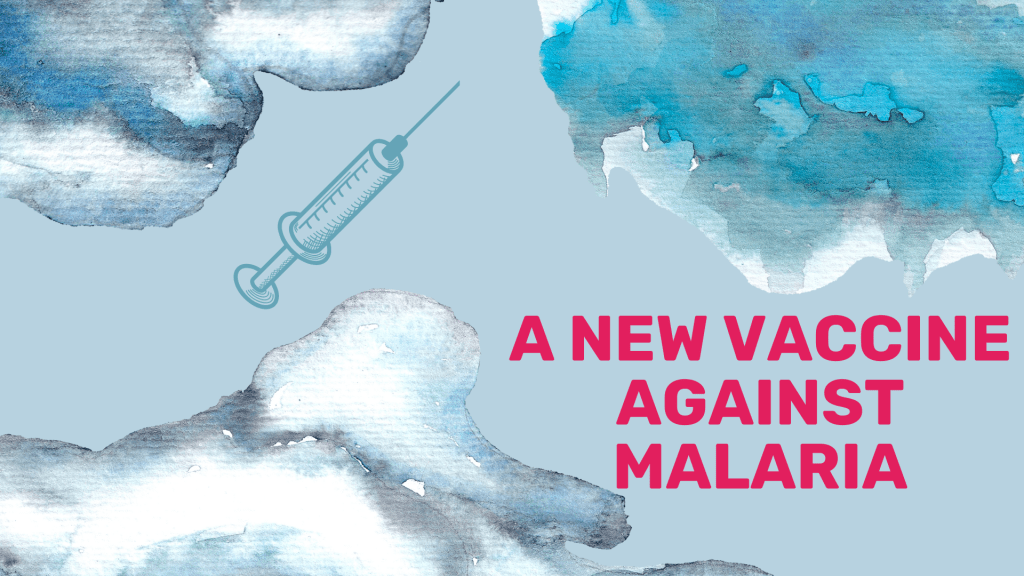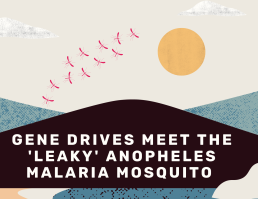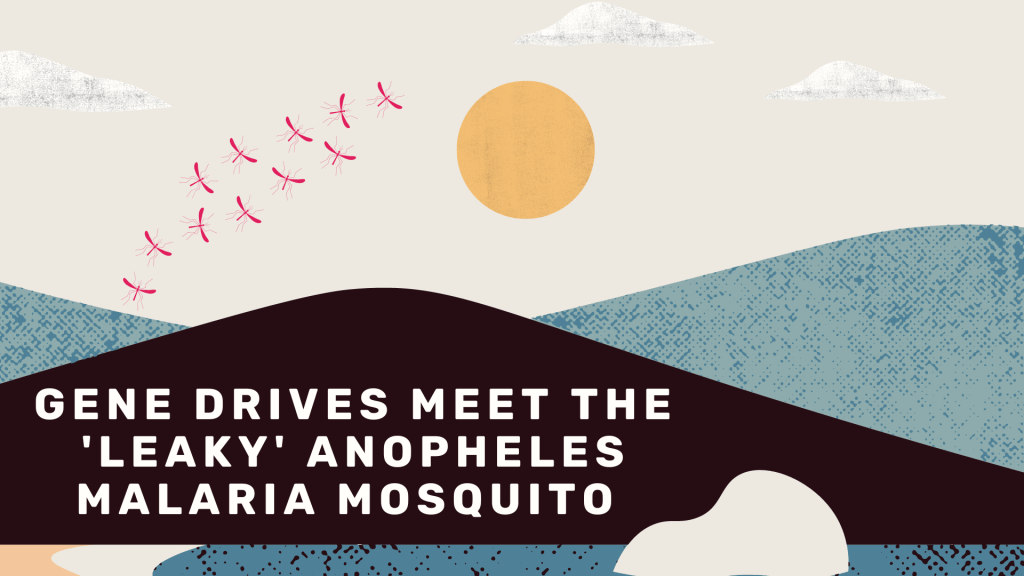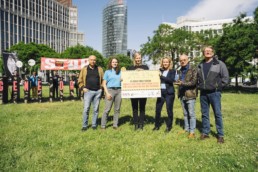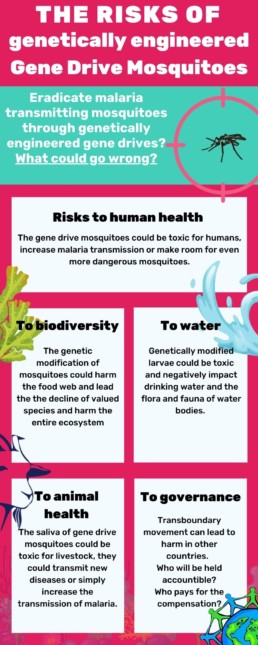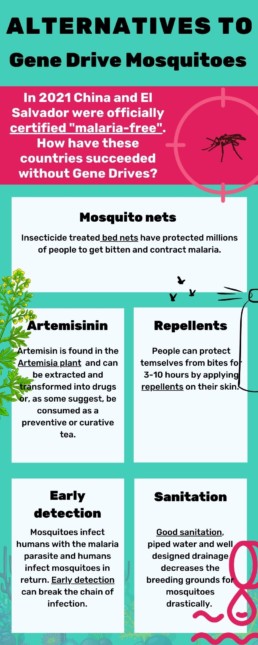News
What happened to Gene Drives at COP15 of the UN Convention on Biodiversity?
What happened to Gene Drives at COP15 of the UN Convention on Biodiversity?
In December 2022, States from all around the world gathered in snowy Montreal to discuss the future of biodiversity protection and conservation until 2030. What did they have to say about new technologies such as gene drives?
The Post-2020 Biodiversity Framework (GBF) has been often referred as a ‘breakthrough’ to halt biodiversity loss. However, the discussions and decisions made in Montreal left synthetic biology watchdogs, like the Stop Gene Drives Campaign, with a bitter aftertaste of corporate influence.
Biotechnology giants such as Brazil and Argentina strongly negotiated to remove any mentions to the precautionary principle and risk assessment from all texts. There was also persistence in inserting the dogma of ‘innovation’ wherever possible. After five Open Ended Working Groups over the course of three years and two weeks of COP15 discussions, the world is left with a Target 17 on Biotechnology that does not do anything beyond reiterating the CBD Convention of 1992. One clear sign that the world of biotechnology has evolved since 1992 is that some of the negotiators sitting at the table today were born in that year. Unfortunately, the new Post-2020 Biodiversity Framework does not seem to keep up with it.
In good time, not all was gloom in Montreal. In addition to adopting the GBF, COP15 managed to set up a new multidisciplinary Ad-Hoc Technical Expert Group for horizon scanning, monitoring and technology assessment of synthetic biology. “Expertise from a broad range of scientific disciplines, as well as interdisciplinary and intercultural expertise, indigenous peoples and local communities” will be included in the process.
Another constructive aspect of the decision is that the conflict of interest resolution from the COP14 will apply, aiming to ensure the scientific integrity and independence of the work of expert groups. It builds on harmful past experiences revealed in the Gene Drives Files (= documents obtained under the US freedom of information provisions showing that the Bill and Melinda Gates Foundation financed an agribusiness public affairs firm to covertly skew an expert process under the CBD in order to lobby against the regulation of GDOs). This is an attempt to confine so called ‘independent’ scientist acting on behalf of philanthropists and billionaires in CBD expert groups.
When it comes to the particular issue of gene drives, the most relevant decision was taken at the meeting of the Parties to the Cartagena Protocol (CP-MOP 10). This Protocol manages biosafety matters. Gene Drives present new uncharted challenges in comparison to ‘classic’ Genetically Modified Organisms covered by the Protocol. Accordingly, an Ad-Hoc Technical Expert Group was established in Montreal to develop additional guidance materials on risk assessment and management of gene drive organisms. Important to note: without the ‘m’ of multidisciplinary.
The focus area of this group will be gene drive mosquitoes, as for them gene drives have been furthest developed to date. These guidance materials will be of voluntary nature, but will help to inform risk assessment globally and, hopefully, unveil open questions, concerns and challenges regarding impacts of gene drives on the environment.
What lies ahead?
The next one to two years are decisive for the (multidisciplinary) technical expert groups scanning biotechnologies like gene drives and working on guidance materials. In the meantime, governments and their institutions, Indigenous Peoples and Local communities, and civil society organizations can submit information to be considered by the expert groups. These actors can also directly participate in online forums to raise their concerns and open questions on synthetic biology and gene drives.
At the next COP (16) in Turkey, States will discuss whether the process of horizon scanning and technology assessment should be continued. They will as well present the indicators that will help to measure the progress of reaching Target 17. We are curious to see how the ‘successful’ attainment of that Target will be measured and for what sorts of projects governments will be eligible for funding.
In short, this means two broad possibilities. On the one hand, the UN CBD could continue requesting risk assessment of new technologies such as gene drives in order to be able to measure all their impacts on biodiversity. On the other hand, the process can be cut short and no risk assessment would be guaranteed.
Finally, when it comes to gene drives under the Cartagena Protocol we hope that the process will genuinely work towards better equipping national governments for risk assessment of gene drives.
At the Stop Gene Drives campaign, we believe that a thorough and holistic risk assessment of gene drives will further expose that current levels of scientific understanding are not sufficient to predict their (irreversible) potential impacts. This would bring yet more clarity on why the release of gene drives into the environment is incompatible with the objectives of the Convention and its Protocols.
Further COP related posts/articles by the Stop Gene Drive Campaign:
ECO articles during the COP15:
01.12.2022 Gene drives are the opposite of nature conservation
05.12.2022 Ecuador’s Galápagos Islands are not a laboratory for testing risky gene drive organisms
07.12.2022 All CBD watchdogs should guard against synthetic biology threats to biodiversity
10.12.2022 Brazilian intransigence on biotech is a violation of human rights
18.12.2022 Snowman to snow-mess: negotiations at COP15 are opening doors to risky technologies
Blogpost leading up to the Conference:
Gene drives are the opposite of nature conservation

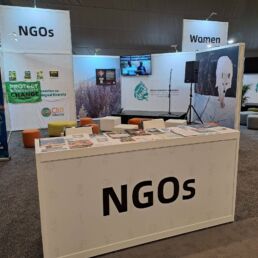

Gene drives are the opposite of nature conservation
Civil society organisations around the globe demand a moratorium on genetically engineered gene drives at UN Biodiversity Conference
Berlin, 1 December 2022 – Ahead of the UN Biodiversity Conference COP 15 and its Cartagena Protocol on Biosafety in Montreal over 140 civil society organisations from Africa, Asia, Europe, Australia and the Americas have issued a joint manifesto exposing alarming risks of environmental releases of genetically engineered gene drive organisms which could lead to irreversible ecological consequences and drive entire species into extinction.
Gene drives use new genetic engineering techniques such as CRISPR-Cas to forcibly spread new genetic information within the genome of populations and entire species of organisms in nature, including traits that can cause their extinction. The signatories of the manifesto are urging national governments at COP15 to resolve critical legal, environmental, biosafety and governance issues as well as fundamental ethical and cultural questions before considering any environmental release of gene drive organisms.
The call for a global moratorium is consistent with demands at previous occasions including at COP13 in Cancun and COP14 in Sharm El-Sheikh. “This controversy will not go away”, said Barbara Pilz, who coordinates the international Stop Gene Drives campaign. “We will continue to fight for a global moratorium on this pretentious concept of reprogramming and extincting entire species in nature.”
The manifesto highlights the need for thorough and genuine risk assessment and uncovers the lack of participatory decision-making processes on this topic to date. It proposes the inclusion of multi-disciplinary expertise and respect for diverse knowledge systems in any processes of technology assessment involving gene drives. This should include indigenous peoples and local communities whose territories are among those being proposed for the first releases of gene drive organisms.
Recalling the goals of the UN Convention on Biological Diversity, Pilz added:
“We urge decision makers at COP15 to approach the issue of gene drives with utmost caution. Once released, they cannot be controlled, reversed or recalled and will respect no borders. This technology adds immense risks to the conservation of biological diversity and is at odds with the concept of nature protection. Let us not create another destructive legacy to future generations. ”
Representatives of the Stop Gene Drives campaign and of other signatories of the manifesto will attend the events of the Convention on Biological Diversity in person in Montreal this December and can be reached for comment. They will join other strong civil society voices striving for inclusive and participatory processes of precautionary technology assessment and equitable decision making on the subject of synthetic biology and gene drives.
The full text of the manifesto is available here and it is still open for signature.
Contact details in Montreal:
Naomi Kosmehl (Public Relations Lead) – kosmehl@saveourseeds.org
Barbara Pilz (Campaign Manager) – pilz@saveourseeds.org
Phone number: +49 152 23 678426
Further links:
Brochure – Gene Drive Organisms. A New Dimension Of Genetic Engineering: Applications, Risks and Regulation.
Video interview series – Worldwide: Experts on Gene Drives.
Are gene drives natural phenomena?
One of the most commonly recycled arguments in the world of gene drive research is that gene drives are natural. More specifically, there has been an attempt in the public discussion to make it seem like there is no material difference between an engineered gene drive using CRISPR-Cas technology and a naturally occurring selfish genetic element (which are indeed found occasionally in nature).
Convincing the non-scientific public that there is little difference between a novel, laboratory-based genetic modification, altered to have a genetic trait based on purely human design or intention and an age-old, naturally evolved, evolutionarily beneficial phenomenon is perhaps one of the most useful tricks in the attempt to make gene drive technology more accepted by the public and policy makers. This attempt to change the definition of a gene drive to make it more publically palatable, extending the definition of gene drive to include both natural and synthetic phenomena, was made explicit with the publication of an opinion piece in 2020, penned by gene drive researchers Luke Alphey, Andrea Crisanti, Filippo Randazzo and Omar Akbari, titled ‘Standardising the definition of gene drive’.
A recent scientific letter written by Mark Wells and Ricarda Steinbrecher of Econexus, published in August 2022 in PNAS cell biology, explores these definitions and explains why this shift in definitions is important and cannot go unchallenged. They emphasises why it is particularly important to pay attention to the differences between natural selfish genetic elements and synthetic gene drives, especially in the context of the fraught and high-stakes political and regulatory debate around gene drives currently taking place. They argue that a narrower definition of gene drives is crucial in order to highlight the novelty of the technology- for example the unprecedented, permanent incorporation of homing genes into animals and irreversible genetic chain reaction that is started.
Read the letter from Mark Wells and Ricarda Steinbrecher in PNAS Cell biology here
A new vaccine against malaria
A new vaccine against Malaria
This month saw another breakthrough in the treatment and prevention of malaria, this time with the publication of the phase 2 clinical trial results of the new University of Oxford R21 vaccine against malaria. This vaccine demonstrated an 80% efficacy against malaria, the highest efficacy ever seen in a malaria vaccine. Professor Adrian Hill, co-creator of the Astra Zeneca vaccine, describes it as “the best malaria vaccine yet” and has stated that it could help to reduce deaths from Malaria by 70% by 2030 and could eradicate it by 2040¹. This is a stunning milestone in the campaign to eradicate malaria, an extremely promising therapeutic which could help us end malaria for good. This new vaccine could be viewed as an intervention with minimal risk, and maximal gain- with this development, the case against using the extremely risky, untried and poorly tested gene drive mosquito as a tool to end malaria comes further into question.
Malaria vaccine development has been historically plagued with difficulties, with over 100 potential candidates and so far only one approved vaccine, Mosquirix, approved in 2021². This difficulty stems from the fact that the Plasmodium parasite has many developmental stages, meaning there are thousands of potential targets³. The Mosquirix vaccine has had a difficult start, with a lower efficacy of around 30% for 4 years and is limited in the number of doses that can be produced. That said, there is still good data available for its effectiveness when used in combination with preventative chemotherapy, with one recent study from the London School of Hygiene and Tropical medicine showing a 70% reduction in the chance of hospitalisation and severe illness or death from malaria⁴. However, the new R21 vaccine, developed at the Jenner Institute at Oxford University, shows the highest efficacy yet seen in a malaria vaccine, the first of its kind to surpass the minimum 75% efficacy goal set by the World Health Organisation.
The R21 vaccine trial took place in Burkina Faso, and was carried out in 450 infants between 5-17 months old, the demographic most in need of treatments and prevention of malaria, with 16 percent of deaths in children in Africa caused by malaria. The cohort was split into two groups receiving the new vaccine and one control group: Two groups received a dose of the vaccine with either a higher or lower amount of immune-stimulating adjuvant respectively and the other group received a rabies vaccine as the control group. All of the children received three doses four weeks apart followed by a 4th dose one year later, and were followed for the full two years to see how the vaccine (or control treatment) affected the cases of malaria observed within the cohort.
The higher adjuvant dose performed best, with an 80% relative risk reduction of contracting malaria in the high-adjuvant group compared with the control group, with no serious side-effects reported. The R21 vaccine targets the Plasmodium parasite before it develops in the blood shortly after someone is bitten and is based a small protein from the immature malaria parasite combined with the Matrix-M adjuvant to help increase the immune response⁵. Despite the success, before approval the R21 vaccine must still be tested in larger groups during the ongoing phase 3 trials, involving 4,800 children in Burkina Faso, Mali, Kenya and Tanzania. Professor Halidou Tinto, the trials principal investigator, is confident that the efficacy will be replicated in these phase 3 trials.
R21 marks a real revolution and beacon for hope in the treatment and prevention of malaria. The path towards a vaccine for malaria has been far from smooth, but the potential for bringing us closer to the eradication of malaria in Africa is huge. The vaccine is both very effective, easy to produce and, very importantly, possible to produce for a few dollars- it is possible to produce 200 million doses per year reasonably through the Serum Institute of India and could therefore be rolled out quickly and widely. Professor Tinto hopes that the vaccine will be used from 2023 in around 250,000 children in Burkina Faso, thus maximising the beneficial effects of the vaccine to those who need it most on a short timeline⁶. With innovative new treatments and preventatives emerging such as the R21 vaccine, the chances of drastically reducing the malaria burden and even achieving eradication are looking ever more likely.
References
¹’⁶Anon, 2022. New malaria vaccine comes a step closer as experts say it’s ‘the best yet’. The Guardian. Available at: https://www.theguardian.com/global-development/2022/sep/07/malaria-vaccine-truss-cut-funding [Accessed September 26, 2022].
² Laurens MB. RTS,S/AS01 vaccine (Mosquirix™): an overview. Hum Vaccin Immunother. 2020 Mar 3;16(3):480-489. doi: 10.1080/21645515.2019.1669415. Epub 2019 Oct 22. PMID: 31545128; PMCID: PMC7227679.
³ Mahmoudi S, Keshavarz H. Malaria Vaccine Development: The Need for Novel Approaches: A Review Article. Iran J Parasitol. 2018 Jan-Mar;13(1):1-10. PMID: 29963080; PMCID: PMC6019592.
⁴ Chandramohan, D. et al., 2021. Seasonal malaria vaccination with or without seasonal malaria chemoprevention. New England Journal of Medicine, 385(11), pp.1005–1017.
⁵ Datoo, Mehreen & Magloire, Natama & Somé, Athanase & Bellamy, Duncan & Traore, Ousmane & Rouamba, Toussaint & Tahita, Marc & Ido, N & Yameogo, Prisca & Valia, Daniel & Millogo, Aida & Ouedraogo, Florence & Soma, Rachidatou & Sawadogo, Seydou & Sorgho, Faizatou & Derra, Karim & Rouamba, Eli & Ramos-Lopez, Fernando & Cairns, Matthew & Tinto, Halidou. (2022). Efficacy and immunogenicity of R21/Matrix-M vaccine against clinical malaria after 2 years’ follow-up in children in Burkina Faso: a phase 1/2b randomised controlled trial. The Lancet Infectious Diseases. 10.1016/S1473-3099(22)00442-X.
Can gene drives spread between mosquito species?
Can gene drives spread between mosquito species?
The issue of Malaria in Africa has for a long time been at the forefront of the discussion about gene drive technology. Leading the research is Target Malaria, a non-profit aimed at using genetic means to eliminate malaria. However, despite the initial success in their laboratory studies, there are glaring open questions and unknowns around releasing gene drive Anopheles gambiae sensu strictu mosquitoes into the environment.
High on the list of concerns are the ecological effects. The risk to an ecological system is considerable when we are talking of eliminating just one species. However Anopheles gambiae sensu strictu is just one member of at least nine mosquito species in the ‘Anopheles gambiae complex’ (known as A. gambiae sensu lato, i.e ‘in the wider sense’), a family of mosquito species that look identical and are well-known to interbreed and produce young hybrids that are capable of breeding1. This has already been troublesome for the fight against malaria as it has been shown to lead to the exchange of mutations that help the survival of species within the complex. For example, Anopheles arabiensis acquired genes that make it resistant to dry and arid conditions through A. gambiae s.s and A. coluzzi, and A. coluzzi acquired a gene for insecticide resistance through A. gambiae s.s2,3,4. In the context of a gene drive, which actively forces inheritance of a chosen gene upon all its offspring, the consequences of the exchange of genes between species is even more concerning.
The real risk comes when the target of the gene drive is taken into account. The doublesex gene is an essential gene for sexual development, and thus the disruption of it means females develop into intersex, infertile adults that cannot reproduce5. Breeding rates drop drastically, and the population crashes. Because of its vital importance to mosquito survival, the gene is called ‘highly conserved’- this means natural selection puts a strong pressure on it remaining unchanged. This is useful to the development of a gene drive as it means that less genetic ‘resistance’ develops and the gene drive is more likely to spread without problems. However, it turns out that this gene is so vital to insect development that it remains almost identical in sequence across the whole Anopheles complex (and even across all insects ever investigated for the gene, making interspecies spread through horizontal gene transfer a further risk)6. This identical genetic target, together with the fact of interbreeding, means there is no barrier remaining preventing the gene drive potentially spreading and crashing all 9 species of the A. gambiae complex in Africa. Six of the species under threat play either no or only minor roles in malaria transmission- just the three species A. gambiae sensu strictu, A. coluzzi and A. arabiensis are considered to be major vectors of malaria7,8.
From the linear, simple perspective of malaria control, it could be argued that this is beneficial- why risk it and leave any possibility that other A. gambiae complex species could take over the role of A. gambiae s.s in transmitting malaria? This concern is justified as the replacement of one vector with another has occurred at least once, with Anopheles funestus being replaced with Anopheles rivolurum after the habitat was sprayed with insecticide in rural Tanzania9. However, from an ecological perspective, the elimination of the whole A. gambiae species complex could imply ecological catastrophe. A recent landmark study demonstrated that the alteration of even one gene in a plant that insects rely on can significantly increase the likelihood of insect extinction10. If the alteration of even one gene can have a detrimental impact on biodiversity, it leads naturally to the question of what happens when 9 species are eliminated.
There is an incredible lack of research on the ecological role of A. gambiae, and the little there is seems to be mostly from Target Malaria themselves. To carry out a risk assessment that is in any way close to satisfactory for a gene drive, this ought to be the first priority. However the few studies there are demonstrate an important ecological role of mosquitoes; one study Target Malaria published showed that around 95% of the larvae of the A. gambiae complex are eaten before they develop11. Furthermore, a recent study showed that the number and diversity of birds and dragonflies were reduced following the use of a biological insecticide12. Pollination, vital for the ecosystem, is also at risk; as well as being prey for other insects and birds that are pollinators, Anopheles mosquitoes also need sugar to survive. Mosquitoes actually need to feed on sugar through feeding on nectar more frequently than they do on blood. This behaviour may also play a direct role in pollinating13.
Target Malaria recently made the step of acknowledging the spread of their gene drive to other mosquito species14. However, the central concern of the blog and paper seems to be little more than a game of wordplay and regulatory chess regarding how to define the ‘target organism’ for the purposes of making the risk assessment less complicated. Almost unmentioned in this was the ecological risk; the potential ecological destruction that might ensue as a result of the release of a gene drive being let loose into a ‘leaky’ mosquito species complex.
This question must be taken seriously by developers and regulators. Malaria is indeed a serious issue, but risking the effects of environmental collapse on local populations with a direct reliance on a healthy, resilient ecosystem, could be equally or more deadly. However, due to the impossibility of trialling gene drive organisms in the wild before their official release, the extent of this risk could be overlooked until it is too late. The very nature of their design dictates that any release could result in their unfettered spread, due to the ‘genetic chain-reaction’ that ensues. The current methods suggested to reverse gene drives are entirely theoretical, untested and therefore insufficient to use to remedy the situation should the need arise.
This acknowledgement of the likely spread of the gene drive and subsequent crash of the A. gambiae complex should lead to serious questions around whether this is a safe, reasonable avenue to pursue in the fight against malaria. This risk is just one of many in the story of gene drives and is a neglected area of research. These unanswered questions have led us and many others to call for a global moratorium on the release of gene drives until these risks have been satisfactorily ruled out. To read more on our policy recommendations, click here.
1,6,14John B. Connolly, Jörg Romeis, Yann Devos, Debora C.M. Glandorf, Geoff Turner, Mamadou B. Coulibaly, Gene drive in species complexes: defining target organisms, Trends in Biotechnology, 2022
2Barrón MG, Paupy C, Rahola N, Akone-Ella O, Ngangue MF, Wilson-Bahun TA, Pombi M, Kengne P, Costantini C, Simard F, González J, Ayala D. A new species in the major malaria vector complex sheds light on reticulated species evolution. Sci Rep. 2019 Oct 14;9(1):14753. doi: 10.1038/s41598-019-49065-5. PMID: 31611571; PMCID: PMC6791875.
3Fontaine MC, et al. Extensive introgression in a malaria vector species complex revealed by phylogenomics. Science (New York, N.Y.) 2015;347:1258524. doi: 10.1126/science.1258524.
4Fouet C, Gray E, Besansky NJ, Costantini C. Adaptation to Aridity in the Malaria Mosquito Anopheles gambiae: Chromosomal Inversion Polymorphism and Body Size Influence Resistance to Desiccation. PLoS ONE. 2012;7:e34841. doi: 10.1371/journal.pone.0034841.
5Kyrou K, Hammond AM, Galizi R, Kranjc N, Burt A, Beaghton AK, Nolan T, Crisanti A. A CRISPR-Cas9 gene drive targeting doublesex causes complete population suppression in caged Anopheles gambiae mosquitoes. Nat Biotechnol. 2018 Dec;36(11):1062-1066. doi: 10.1038/nbt.4245. Epub 2018 Sep 24. PMID: 30247490; PMCID: PMC6871539.
7Anopheles gambiae (African malaria mosquito, Mosquito, Malaria mosquito, ANOGA) | BCH-ORGA-SCBD-260392 | Organism | Biosafety Clearing-House (Correct as of September, 2022)
8Sinka, M.E., Bangs, M.J., Manguin, S. et al. The dominant Anopheles vectors of human malaria in Africa, Europe and the Middle East: occurrence data, distribution maps and bionomic précis. Parasites Vectors 3, 117 (2010). https://doi.org/10.1186/1756-3305-3-117
9Gillies MT, Smith A (1960) Effect of a residual house-spraying campagn on species balance in the Anopheles funestus group: The replacement of Anopheles gambiae Giles with Anopheles rivulorum Leeson. Bull Entomol Res 51: 248–252.
10Barbour, M. A., Kliebenstein, D. J., & Bascompte, J. (2022). A keystone gene underlies the persistence of an experimental food web. Science, 376(6588), 70-73.
11Collins CM, Bonds JAS, Quinlan MM, Mumford JD (2019). Effects of the removal or reduction in density of the malaria mosquito, Anopheles gambiae s.l., on interacting predators and competitors in local ecosystems. Med Vet Entomol 33:1.
12Jakob C, Poulin B (2016). Indirect effects of mosquito control using Bti on dragonflies and damselflies (Odonata) in the Camargue. Insect Conservation and Biodiversity 9:161.
13Foster WA (1995). Mosquito sugar feeding and reproductive energetics. Annu Rev Entomol 40:443.
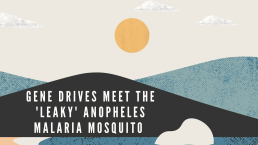
The UN CBD working group is meeting in Kenya these days
What is happening in Nairobi?
Kenya is currently hosting the Fourth Open Ended Working Group on the Post-2020 Global Biodiversity Framework. Delegates from all countries that are part of the United Nations Convention on Biological Diversity are gathering at UN Environment Programme headquarters in Nairobi from the 21st to the 26st of June to discuss goals and targets for the proposed post-2020 Global Biodiversity Framework that will be internationally agreed upon at the full meeting of the UN Convention on Biological Diversity that will be held later in the year. If well designed, this framework could be key to halt and reverse biodiversity loss in the coming decade, a global agreement on halting biodiversity loss comparable to the Paris Agreement on climate change.
Proposed targets range from the protection of the oceans and forests to limiting the adverse impacts business activities have on biodiversity. National delegates, but also NGOs, Youth, Indigenous People, Women and Academics can comment on the targets being discussed and thereby shape what states have to live up to until 2030
Why is the Stop Gene Drive Campaign there?
Stop Gene Drives Campaign is keenly watching all the targets being discussed in Nairobi relating to the assessment, management and regulation of new biotechnologies such as gene drives. Target 17 of the proposed GBF relates to biosafety and deals with potential adverse impacts of biotechnology on global biodiversity. Target 6 deals with invasive species - Gene Drives have been proposed to eliminate them. You can read why we believe that this is a very bad idea here.
A number of other targets relate to horizon-scanning of new technologies for potential threats of new and emerging technologies and to building the foundations for the kind of broad and inclusive risk and technology assessment needed for far-reaching, untested technologies like gene drives.
How to keep up to date?
The voice of civil society at the negotiations can be heard through the CBD Alliance’s daily publication ECO, which you can read online through the link to keep up to date with developments at the meeting in Nairobi. You can also follow them on Twitter to make sure to get notified when the journal is out. We furthermore suggest to follow what the Global Youth Biodiversity Network is posting, because they are a very active part of the civil society from around the world. The Indigenous People Caucus is also posting daily updates! And if you are not doing it already, you can follow us on Twitter and sign up for our newsletter!
300,000 EU citizens call on German environmental minister Steffi Lemke: Stop Gene Drives!
Berlin, 31 May 2022 – Almost 300,000 citizens of the European Union are calling for a global moratorium on the first field release of genetically modified gene drive organisms. The associations Save Our Seeds, the Aurelia Foundation and the Munich Environmental Institute, which are part of the European Stop Gene Drive campaign, handed over a petition to this effect to the German environmental minister Steffi Lemke in Berlin on 31st of May 2022. Enabled by the novel genetic engineering method called gene drive, wild species could be manipulated or even completely eradicated in the future – with unforeseeable consequences for ecosystems.
Gene drives are produced with the help of the new genetic engineering techique CRISPR-Cas. Gene drives can genetically modify or even eradicate entire populations of animals and plants in nature. The so-called gene drive overrides basic principles of evolution and forces the inheritance of a genetic trait to all offspring. This triggers a genetic chain reaction that only stops when all individuals of the affected animal or plant species carry this genetic modification – or have been exterminated. This is intended, for example, to combat disease-carrying insects, invasive species or so-called crop pests in industrial agriculture.
So far, gene drives have only been tested in the laboratory. Now, the research consortium ‘Target Malaria’ in the West African country of Burkina Faso wants to release gene drives into nature for the first time. The goal is to eradicate a mosquitoe species that transmits malaria. But what sounds promising carries enormous risks: once released into the wild, gene drives can neither be retrieved nor can their further development and spread be controlled. If gene drive organisms spread, they could further accelerate the already rapid extinction of species.
At the handover event with German environmental minister Lemke on Leipziger Platz in Berlin, an installation of giant toppling dominoes vividly depicted the risks posed by the gene drive process.
“A genetic chain reaction triggered by Gene Drive organisms could destabilize entire ecosystems and, in extreme cases, cause them to collapse. Every gene drive release – even if it is “only” for experimental purposes – can have unforeseeable and irreversible consequences for pollinator and food webs, already weakened by climate change and high death rate of insects. We urgently need a global gene drive moratorium!”
warns Bernd Rodekohr, manager of the project “Protect the bee from genetic engineering” at the Aurelia Foundation.
“Gene drive organisms do not respect borders and can spread globally,” says the coordinator of the Stop Gene Drive campaign, Mareike Imken. “So far, the global community has neither sufficient knowledge nor binding international agreements under which such a fundamental, irreversible intervention in nature could be regulated.”
The possible use of gene drives is on the agenda of the 15th United Nations Conference of the Parties to the Convention on Biological Diversity (UN CBD), scheduled for autumn in China. EU environment ministers will adopt their common position on the issue in June.
Sophia Guttenberger of the Munich Environmental Institute demands: “Instead of playing Russian roulette with evolution by genetically modifying wild species, we must finally stop the already rapid extinction of species by strengthening the resilience of our ecosystems and stop destroying them everywhere on earth.”
The German envionmental minister Steffi Lemke said at the petition handover:
“I believe that humanity and also science would overestimate themselves with Gene Drives. That’s why I will of course try to reach a position at the Environmental Council of Ministers in June that is based on the European precautionary principle.”
Background:
Gene drive technology uses genetic engineering methods such as the ‘gene scissors’ CRISPR/Cas to introduce certain traits into wild animal and plant populations. For example, if genes that influence fertility or sex are manipulated, entire populations can be wiped out. However, gene drives could also make so-called agricultural pests susceptible to chemical or biological substances or change other characteristics. To do this, both the new trait and the genetic engineering mechanism (CRISPR/Cas) are passed on. In this way, the genetic manipulation continues independently in nature. This “genetic chain reaction” causes all offspring to inherit the desired trait until the entire population or species is genetically modified or eradicated.
Since 2018, the regulation of gene drives has been the subject of controversial debate under the UN Convention on Biological Diversity (UN CBD). At the last Conference of the Parties in Sharm el Sheik, some initial precautionary conditions for release were recommended. But many questions remain unanswered – including, above all, how and by whom the decision on a release of gene drive organisms would have to be taken in view of transboundary spread and unforeseeable ecological, health, economic and social consequences. The existing procedures under the internationally binding Cartagena Protocol of the CBD on Biosafety so far only regulate the intended transfer of genetically modified organisms (e.g. seeds) as products across individual borders. Gene drive organisms, on the other hand, are not products and spread independently in all regions where the target organism is currently present or will be present in the future. In this respect, all potentially affected countries would have to give their consent to a release in advance. Currently, however, only international guidelines for the risk assessment of gene drive organisms and a general process for the technology assessment of new biotechnological processes are on the agenda of the negotiations within the framework of the UN Convention on Biological Diversity. Goal 17 of the planned Global Framework for Biodiversity deals with the prevention of biodiversity damage due to the use of biotechnologies.
Further links:
– For the Stop Gene Drive Campaign’s recommendations on the design of a global gene drive moratorium: https://www.stop-genedrives.eu/en/policy-recommendations/
– To the brochure “Gene Drives. The new dimension of genetic engineering. Applications, risks and regulation.” https://www.stop-genedrives.eu/en/own-publications/
– 15-minute short documentary on the risks and challenges posed by gene drive technology: https://www.youtube.com/watch?v=PLt6ILhQZ7E&t=4s&ab_channel=SaveourSeeds
– All important information about the Stop Gene Drive campaigns on this website and on Twitter.
Press contact:
Mareike Imken
Coordinator of the Stop Gene Drive Campaign
Save our Seeds / Berlin Office of the Future Foundation for Agriculture in the GLS Trust
E-mail: imken[at]saveourseeds.org
Mobile: 0151-53112969
Web: www.stop-genedrives.eu
World Malaria Day 2022
What risks are we willing to take to (maybe) end malaria?
25.04.22 – After a tremendous decrease in malaria cases in the last two decades, malaria is on the rise again, having killed 677.000 people in 2020, among them 80% children under 5. Apart from being deadly, malaria is detrimental for the livelihoods of entire families, communities and countries: farmers not being able to sow their seeds on time, mothers not being able to sell surpluses on markets to earn a living or children not being able to go to school and benefit from education – a vicious cycle of poverty. While this disease affects one third of the world’s population, some scientists suggest that a new technology called gene drive could be a game-changer.
Gene Drives – manipulating the DNA of mosquitoes to pass down an extinction gene
The research consortium Target Malaria, mostly funded by the Bill & Melinda Gates Foundation and the Open Philanthropy Fund, is developing genetically engineered mosquitoes in the lab that would either make all offspring male or all female offspring infertile. They use the Crispr-Cas methodology to implant a system into their DNA that would replicate when mosquitoes mate, ensuring that this gene spreads throughout the wild mosquito population. But while some hope that this would be the magic bullet to suppress mosquitoe populations and stop the malaria transmission cycle, this currently unproven high risk technology poses fundamental questions for humanity: How far are we willing to go, how high can the risks and uncertainties be in order to test a hypothesis?
The Risks of Gene Drive mosquitoes
The risks and consequences of genetic engineering are very hard to predict, especially when the organism is supposed to live and mate in the wild. This is because genes do not only affect the physical shape of animals but also their behavior, their interactions with other species and the way bacteria and parasites affect them. A suppression/eradication gene drive is going to have repercussions along the entire food web and would likely mean that their ecological niche will be occupied by another species, and that the plasmodium parasite (which causes malaria) would lack a host – with unknown consequences. In addition, there is a risk that the modified genes could be passed from the mosquitoes via ‘horizontal gene transfer’ to other species and suppress their population too. If this would affect so called “valued species”, the ecosystems could collapse or be severely damaged.
At this point in research scientists do not know if the genes might be toxic for humans or create allergic reactions. Furthermore, the expected change in behavior of the mosquitoes could lead to increased biting and/or even increased malaria transmission. Also, if humans eat animals that ate the gene drive mosquitoes before they could suffer from secondary toxic effects. Last but not least, if the anopheles gambiae mosquito is eradicated, potentially another mosquito could take its spot, increasing the burden of other diseases.
Same as for humans, gene drive mosquitoes could be toxic for livestock, transmit new diseases or may even – counter-intuitively – increase the transmission of malaria.
Mosquito larvae play an important role in water bodies. Genetically modified larvae could be toxic and negatively impact drinking water and the flora and fauna of water bodies.
As this technology is still very new, naturally studies and discussions on their risks, possible adverse consequences as well as the type of global governance and international regulation needed are only in their infancy. For example, guidance materials for risk assessment have not even been commissioned by the global community. In addition – a plethora of important political, socio-economic, cultural and ethical questions remain unaddressed and unanswered. For example, who should be included in the decision making process and who should be consulted before any release? Would it be enough that a national government such as the Burkinabe government allows such a release and that local village chiefs give their consent? How would decision-making processes be designed to uphold the internationally enshrined rights of Indigenous peoples and local communities to say no to projects that could affect them and their territories? Who would be held responsible and who would have to pay for compensation if the gene drive mosquitoes crossed borders and had adverse impacts on ecosystems or farming in non-target environments?
At the same time there are measures at hand that have in the past been used to end malaria in countries such as, most recently, China and El Salvador, being officially declared malaria free in 2021, preceded by Algeria and Argentina in 2019.
What have been the most successful tools to fight malaria?
Research suggests that the number one tool for the decrease of malaria since 2000 are insecticide-treated bed nets. Approximately 65% of the progress achieved between 2000 and 2015 result from the use of these nets.
Poor Water and Sanitation conditions are associated with a number of diseases, among others with the occurrence of malaria. A better sanitation situation would be a holistic approach to fight malaria, while also fighting diarrhea and respiratory infections that kill millions of children every year. Further research shows that good sanitation and piped water are associated with a lower prevalence of malaria among the population. Dr. Sory shares this opinion and believes that correct drainage systems would heavily lower the burden of malaria.
Artemisinin was rediscovered by the Nobel Prize laureate Tu Youyou who found the cure for malaria in traditional books. It is a component from the Artemisia plant. Drugs against Malaria now often contain artemisinin and can cure all malaria strains present nowadays. Initial research suggests that a tea prepared with the Artemisia plant can have preventive and curative effects. It seems that another plant of the Artemisia family, Artemisia afra, could have similar effects, without containing artemisinin. Lucile Cornet-Vernet and Arnaud Nouvion said that more clinical studies are needed to prove once and for all that these plants work. Until now the WHO asks to not use the plant as tea to not cause resistance to artemisinin. Resistances to artemisinin have been discovered in South-East Asia, but not in Africa so far. Lucile Cornet-Vernet on the other hand points to the fact that in China, this plant has been used for about 2000 years and no resistance has been discovered there yet. Furthermore, the plant comes with a variety of components that could potentially cure malaria, thereby being a “poly-therapy”. Access to health care providers diagnosing malaria and prescribing the drug and the financial means to afford them are the limiting factor here. Or else access to seeds or the Artemisia leaves to cure oneself could be useful, if clinical studies can be conducted and no link to the creation of resistance can be drawn.
There is a multitude of repellents that can protect humans between 3-10 hours from mosquito bites. Seen that most mosquitoes bite in the evening/night, this protection is very helpful when going out late. Many of them have chemical ingredients and some have plant-based ingredients. Amongst those, the German society for tropical medicine, travel medicine and global health recommends only the ones with oil from the lemon eucalyptus and points out that for the other natural repellents too little studies have been conducted. This could be a path worth exploring.
Early detection helps people first to get the needed medicine as soon as possible, suffer the least impact of the disease, and second it helps to decrease the risk of a local outbreak in a community.
A new vaccine was recently approved by the WHO for children under 5 years old. A pilot phase was concluded in Ghana, Malawi and Kenya. Employed prior to high transmission periods of malaria this vaccine seems to have positive affects on immunization. It is recommended that children above 5 months get four doses of the vaccine. Over a 4 years follow-up the efficacy of the vaccine against malaria was 36%.
Why is there still malaria in the world then?
To fight malaria the whole toolbox of measures (as mentioned above) needs to be employed, ranging from prevention through nets and repellents, to access to rapid tests to break the infection chain and access to medicine a few hours after being bitten to cure humans. Adding to this; a holistic approach, including urban planning, education, drainage systems and access to health care is needed to fight malaria – as well as many other diseases that trap people in poverty and create a vicious cycle.
What is the Stop Gene Drives Campaign asking for?
In light of the huge variety of to date unassessed possible environmental, health and socio-economic hazards, the potential for economic and political conflict and a plethora of social, ethical and cultural caveats that the environmental use of gene drive technology would entail , the Stop Gene Drive Campaign demands a global moratorium on the release of gene drive organisms. This means that no gene drive organism should be allowed to be released into the environment – not even for field trials – unless a range of conditions have been fulfilled. Read our policy recommendations here.
It seems to us that malaria prevention funds should be directed at strengthening local health care systems, sanitation and education to turn the fight against malaria into an intersectional approach to fight poverty and neglected diseases in general.
__________
Further readings:
Read more about possible gene drive applications here
Read our FAQ about gene drives here
Read more about gene drive regulation here
Read our interviews with experts on malaria prevention here
_________
References:
Connolly, J. B., Mumford, J. D., Fuchs, S., Turner, G., Beech, C., North, A. R., & Burt, A. (2021). Systematic identification of plausible pathways to potential harm via problem formulation for investigational releases of a population suppression gene drive to control the human malaria vector Anopheles gambiae in West Africa. Malaria Journal 2021 20:1, 20(1), 1–69. https://doi.org/10.1186/S12936-021-03674-6
Czechowski, T., Rinaldi, M. A., Famodimu, M. T., Van Veelen, M., Larson, T. R., Winzer, T., … Graham, I. A. (2019). Flavonoid Versus Artemisinin Anti-malarial Activity in Artemisia annua Whole-Leaf Extracts. Frontiers in Plant Science, 10, 984. https://doi.org/10.3389/FPLS.2019.00984/BIBTEX
ENSSER, VDW, & Critical Scientists Switzerland (CSS). (2019). Gene Drives. A report on their science, applications, social aspects, ethics and regulations. Retrieved from https://ensser.org/publications/2019-publications/gene-drives-a-report-on-their-science-applications-social-aspects-ethics-and-regulations/
Guidance on the environmental risk assessment of genetically modified animals. (2013). EFSA Journal, 11(5). https://doi.org/10.2903/J.EFSA.2013.3200
Landier, J., Parker, D. M., Thu, A. M., Carrara, V. I., Lwin, K. M., Bonnington, C. A., … Nosten, F. H. (2016). The role of early detection and treatment in malaria elimination. Malaria Journal, 15(1), 1–8. https://doi.org/10.1186/S12936-016-1399-Y/TABLES/1
Laurens, M. B. (2020). RTS,S/AS01 vaccine (MosquirixTM): an overview. Human Vaccines & Immunotherapeutics, 16(3), 480. https://doi.org/10.1080/21645515.2019.1669415
Malariaprophylaxe und Empfehlungen des Ständigen Ausschusses Reisemedizin (StAR) der DTG. (2021, August). Retrieved April 18, 2022, from https://www.dtg.org/images/Startseite-Download-Box/2021_DTG_Empfehlungen_Malaria.pdf
Maskin, E., Monga, C., Thuilliez, J., & Berthélemy, J. C. (2019). The economics of malaria control in an age of declining aid. Nature Communications 2019 10:1, 10(1), 1–5. https://doi.org/10.1038/s41467-019-09991-4
Okumu, F. O., Govella, N. J., Moore, S. J., Chitnis, N., & Killeen, G. F. (2010). Potential Benefits, Limitations and Target Product-Profiles of Odor-Baited Mosquito Traps for Malaria Control in Africa. PLOS ONE, 5(7), e11573. https://doi.org/10.1371/JOURNAL.PONE.0011573
Prüss-Ustün, A., Wolf, J., Bartram, J., Clasen, T., Cumming, O., Freeman, M. C., … Johnston, R. (2019). Burden of disease from inadequate water, sanitation and hygiene for selected adverse health outcomes: An updated analysis with a focus on low- and middle-income countries. International Journal of Hygiene and Environmental Health, 222(5), 765–777. https://doi.org/10.1016/J.IJHEH.2019.05.004
Q&A on RTS,S malaria vaccine. (n.d.). Retrieved April 18, 2022, from https://www.who.int/news-room/questions-and-answers/item/q-a-on-rts-s-malaria-vaccine
Target Malaria. (n.d.). The Science: What is gene drive? Retrieved from www.targetmalaria.org/ourwork
Target Malaria | Together we can end malaria. (n.d.). Retrieved April 25, 2022, from https://targetmalaria.org/
The Nobel Prize | Women who changed science | Tu Youyou. (n.d.). Retrieved April 19, 2022, from https://www.nobelprize.org/womenwhochangedscience/stories/tu-youyou
WHO. (2019). The use of non-pharmaceutical forms of Artemisia. Retrieved April 19, 2022, from https://www.who.int/news/item/10-10-2019-the-use-of-non-pharmaceutical-forms-of-artemisia
WHO. (2022). Countries and territories certified malaria-free by WHO. Retrieved April 18, 2022, from https://www.who.int/teams/global-malaria-programme/elimination/countries-and-territories-certified-malaria-free-by-who?msclkid=949a737cbf0711ec9474c0ab673942f3
Yang, D., He, Y., Wu, B., Deng, Y., Li, M., Yang, Q., … Liu, Y. (2020). Drinking water and sanitation conditions are associated with the risk of malaria among children under five years old in sub-Saharan Africa: A logistic regression model analysis of national survey data. Journal of Advanced Research, 21, 1–13. https://doi.org/10.1016/J.JARE.2019.09.001
Yasri, S., & Wiwanitkit, V. (2021). Artemisinin resistance: an important emerging clinical problem in tropical medicine. International Journal of Physiology, Pathophysiology and Pharmacology, 13(6), 152. Retrieved from /pmc/articles/PMC8784654/
International negotiations on Gene Drives resume in person
15.04.22, Berlin -The UN Convention on Biological Diversity (UN CBD) and its sub-protocols are the world's most important forums for establishing internationally binding regulations for Gene Drive technology. For the first time since the beginning of the COVID pandemic - after more than two years of repeated postponements and online meetings - government officials, civil society, scientists and business lobbyists met in person to resume international negotiations in Geneva (Switzerland) between 14-29 March 2022.
During the two and a half conference weeks three different committees discussed a broad range of issues that had previously only been discussed in several online meetings.
At the centre of the Geneva meetings were negotiations of the so-called Post 2020 Global Biodiversity Framework (GBF) to stop and reverse global biodiversity loss through a shared set of goals and measures by 2050. This agreement will be finalized and voted on at the 15th meeting of the Parties (COP 15) of the UN CBD now scheduled to be held in Kunming, China, in August 2022.
Global Biodiversity Framework, Target 17 - Preventing harm from biotechnologies
With regard to the regulation of biotechnologies such as Gene Drives, discussions around Target 17 were of particular relevance. This target is meant to strengthen measures to protect biodiversity from risks and negative impacts emerging from the use of biotechnologies. The Stop Gene Drive Campaign, as part of a group of like-minded civil society organizations named the CBD Alliance, called for a process to anticipate future technological developments, monitor emerging (bio-)technologies and enable the regulation of these biotechnologies to prevent any harmful impacts. The group also stressed the need to uphold the rights of potentially affected indigenous peoples and local communities - especially the right to say no to the use of biotechnologies that could negatively affect their lands, territories and waters. These rules should also stipulate how damage that nonetheless occurs should be compensated for.
While parties such as Bolivia, Ethiopia and Mexico asked for these elements to be included in the text, other parties, most prominently Brazil, tried to undermine the purpose of this target by including text on the potential benefits that biotechnologies could have for biodiversity. While the CBD Alliance called to monitor a broad range of technologies under this target - some parties wanted to narrow down the types of technologies to be covered by including very specific definitions. This is the report of co-leads of contact group 4 that reflects among other these diverse inputs to the discussion.
SBSTTA - Agenda items 4 and 5: Assessing Gene Drive technology
While discussions around the GBF were mostly held by a committee called the ‘Open Ended Working Group’ Geneva also hosted the meeting of an advisory body to the CBD called ‘Subsidiary Body on Scientific, Technical Technological Advice’ (SBSTTA) that discusses general and long-standing issues under the Convention on Biological Diversity and prepares texts to be adopted by the COP. Some of them are of particular interest with regard to regulating Gene Drive technology:
- Agenda item 4 deals with the topic of synthetic biology, which is an emerging field of biotechnology that seeks to redesign or create new living organisms not existing in nature.
The current state of negotiations on this agenda item are reflected in the draft recommendations on synthetic biology and are the results of online negotiations held in April and May 2021. Discussions focused on the establishment of a process under the CBD to anticipate (i.e. ‘horizon scan’), monitor and assess new technological developments in the field of synthetic biology (such as Gene Drives) and their potential impacts for the protection of biodiversity. The Stop Gene Drive Campaign welcomes the establishment of such a long-term process and encourages the formation of a multidisciplinary technical expert group (MTEG), including transdisciplinary experts that represent a broad range of knowledge systems, in order to assess the potential impacts of these technologies. The Stop Gene Drive Campaign stresses that the assessment process needs to take into account socio-economic, cultural, ethical and health questions. The Stop Gene Drive Campaign also demands to reaffirm the need for a highly precautionary approach regarding the release of Gene Drive organisms into nature and to establish further conditions to be met before any environmental release should even be considered. Due to time constraints this agenda item has not been discussed in Geneva but passed over for further discussion at COP.
- Agenda item 5 deals with the risk assessment of genetically engineered organisms (referred to as living modified organisms, (LMOs)). This particular field is subject to a legally binding sub-protocol of the Convention called the ‘Cartagena Protocol’ signed by most but not all of the parties to the Convention.
The current state of negotiations in the draft recommendations on risk assessment is the result of virtual online negotiations held in April and May 2021. Discussions focused on the question whether (additional) voluntary guidance materials on the environmental risk assessment of Gene Drive organisms should be drawn up. Contentious issues were the scope of these guidance materials and the composition of the drafting group. The Stop Gene Drive Campaign welcomes the establishment of such guidance materials. They should address the specific risks of Gene Drive Organisms in general (as opposed to guidance covering only Gene Drive Mosquitoes). The recommendations should be drafted by a diverse and transdisciplinary group of experts, including civil society and indigenous peoples organizations and operationalize the precautionary principle. Due to time constraints this agenda item has not been discussed in Geneva but passed over for further discussion at COP.
- Agenda Item 6 deals with the topic of invasive alien species, which are considered one of the three major reasons for biodiversity loss. In this context Gene Drives have been proposed by some as a technology to combat invasive alien species.
During discussions on this agenda item in Geneva, Gene Drives have been included in the draft recommendations on invasive species which now demands that when considering Gene Drives to fight invasive species, the precautionary approach should be applied. Further discussions on this will be held at COP.
Next steps
The agenda in Geneva was very dense and parties did not manage to finalize their discussions on most of the texts for the GBF. Therefore the CBD Secretariat has announced to hold further meetings. The ‘Open Ended Working Group’ (OEWG) will therefore continue to discuss the targets (such as target 17) of the GBF from the 21st to the 26th of June in Nairobi, Kenya. Another meeting will be held in Bonn from 29 June to 1 July 2022 for the so called ‘Subsidiary Body on Implementation’ (SBI) to discuss indicators to monitor if the new GBF targets are being properly implemented.
Progress in both meetings will be key so that the framework can be accepted by all parties at the COP to be held in Kunming around August and guarantee a robust agenda to halt and reverse biodiversity loss for the upcoming years.
Links and Resources
- Draft recommendation on synthetic biology (CBD/SBSTTA/24/L.5)
- Draft recommendation on risk assessment (CBD/SBSTTA/24/L.6)
- Draft recommendation on invasive alien species (CBD/SBSTTA/24/L.8)
- Co-leads’ proposals on target 17 of the global biodiversity framework: tools and solutions for implementation and mainstreaming, contact group 4; Non-paper of 23-03-2022; Report by the co-leads of contact group 4, including consolidated text on Target 17, reflecting discussions until 2.09.2021 (CBD/WG2020/3/CG/4/REPORT)
World Wildlife Day
World Wildlife Day:
Dreams & nightmares of genetically engineering wildlife.
Why conservation organisations across the world need to speak up!
Most people in the EU – including civil society organisations – are opposed to genetically manipulating food crops but unaware that the scope of genetic engineering projects has shifted radically in the past decade. With the advent of CRISPR/Cas genetic engineering has been brought to a new level while the previously used ‘gene guns’ that enabled for example Monsantos pesticide resistant corn have become quite outdated. With CRISPR many more species – and not only domesticated ones – can be genetically modified in much more targeted and profound way.
Genetic engineering in conservation?
Impressed by these new possibilities molecular biologists and even some conservation organisations have started to dream of genetic engineering as the magic bullet for nature conservation. Invasive species in particular are subject to research projects which aim to develop so called gene drive organisms. Gene drives – a specific application of CRISPR/Cas-based genetic engineering – ensures that a genetically engineered trait will be inherited by 100% of all offspring of an organism. Gene drive organisms, once released into natural environments, are designed to mate with their wild relatives and make the genetic modification a prevalent trait in the wild population – across generations.
One of the main proponents for using gene drives for invasive species elimination is the conservation organisation called Island Conservation. They have a long record of removing non-native invasive predators – predominantly rodents that threaten birds – from tropical biodiverse islands such as Hawaii and Galapagos. To date, this has been done using conventional methods, but Island Conservation believes that other tools such as gene drives are required. For this reason, Island Conservation initiated the Genetic Biocontrol of Invasive Rodents (GBIRd) project, which is supported by seven universities and non-governmental organizations from the USA and Australia, to investigate the gene drive approach and associated questions.
Mice, squirrels, ferrets, wasps, fruit flies and toads are among the species on the wish to be removed from the ecosystems they invaded and harm. Gene drive developers want to simply add a gene drive to specific genes in the germ cells of these organisms that for example code for the sex of the offspring. This could have the effect that only male or female offspring would be born and the population of the locally undesired species would crash over the course of a few generations.
The first steps to develop a gene drive in mice was taken in 2019 at the University of California in San Diego, USA. This research showed, however, that CRISPR gene drives do not yet work well in mammals.
Have we learned any lessons? Does it make sense to fight invasive species with invasive GMO?
In Queensland, Australia, sugarcane farmers in the past had huge issues with beetles that would destroy their crops. In 1935 cane toads (originally from South America) were introduced to fight the beetles. The cane toads succeeded in suppressing the beetle population but turned into invasive species themselves. Now those toads are a plague and spread throughout Australia as they can poison their predators. Australia’s national scientific research agency (CSIRO) is leading research projects on the elimination of cane toads via gene drive. But who can be sure that with gene drive cane toads history is not going to repeat itself?
A similar approach is pursued by the Roslin Institute in the United Kingdom, where the invasive grey squirrel (imported from North America 150 years ago) has pushed back the native red squirrel and destroys trees and bird nests. The idea here is similar to the one in Australia: A gene drive could either render the offspring infertile or only offspring with one sex would be born.
As Dave Goulson, a professor of biology at Sussex University points out anecdotally:
“We used to eat and persecute red squirrels as pests. We introduced grey squirrels because we thought they were cute. Then they spread and the reds started to decline, so we reversed our opinion, deciding that the reds were now cute and the greys should be killed.”
So would it be a good idea to eliminate the grey squirrel with a gene drive? Here’s just one other idea: Researchers have found that reintroducing almost extinct native predators, such as the pine marten into the UK, would lead to a decline of the grey squirrel and a rise of the red squirrel.
Early warnings: gene drives not suitable for conservation purposes
When New Zealand initially considered to include gene drives as part of their Preditor Free Program to rid the island of invasive species, two gene drive developers in 2017 published an article warning against such a decision.
They warned, that once released, the gene drive organisms, for example mice, could remain on the island for several years. Seen that only a few of these gene drive mice would be needed to infect a whole population, their long existence on the island could enable them to “hitch a ride” to other places.
“If we have learned anything from the spread of invasive species, it is that ecosystems are connected in myriad ways and that a handful of organisms introduced in 1 country may have ramifications well beyond its own borders.”
They also warned that, even if these gene drive mice would not manage to leave the country by travelling along via tradeships or planes, experiences in the field of biocontrol seem to suggest that changes are high that they could be moved deliberately to countries where mice pose high damage to certain industries. For example, in the US alone the total cost of annual losses to rats amounts to US19 billion.
The two authors add, that as gene drive organisms are invasive by design, a handful of escaping rats from islands such as New Zealand to the main land would suffice to eliminate all rat populations, thereby severely damaging ecosystems and biodiversity worldwide. In addition, according to these authors, even developing gene drive organisms in labs within an area where the target species lives is dangerous, as any escape would be fatal.
The way forward: A bigger debate & a global moratorium is needed!
In view of the possibility of using gene drives to remove introduced invasive species from sensitive ecosystems, the International Union for Conservation of Nature (IUCN), has also been discussing this technology since late 2015.
In its Members Assembly at its World Conservation Congress in Marseille in September 2021, the IUCN adopted Resolution 075 that mandates the IUCN to undertake an inclusive and participatory member-driven process to explore the role of genetic engineering and synthetic biology in relation to nature conservation. Based on this exploration, Resolution 075 asks the IUCN to develop a policy on this topic until its next World Congress in 2025.
This process will be an important opportunity for the global conservation scene to learn about these new developments. This process will hopefully provide a space to understand that there are many unanswered questions, knowledge gaps, risks and unassessed ecological aspects, conceptual and legal challenges as well as wider questions such as socio-economic, cultural, ethical and legal impacts associated with the genetic engineering of wildlife that need to be addressed before the IUCN can take a position. This position will send an important message to the ongoing regulatory discussions on the level of the UN CBD.
In the meantime the Stop Gene Drive Campaign is demanding national goverments across the world to impose a global moratorium on the environmental release of (including field trials with) gene drive organisms – as long as these open questions have not been answered and a global consensus on the use of this technology has not be reached.
Read here more about how gene drives work, their risks, about the IUCN discussions, the current state of gene drive regulation and our policy recommendations.

